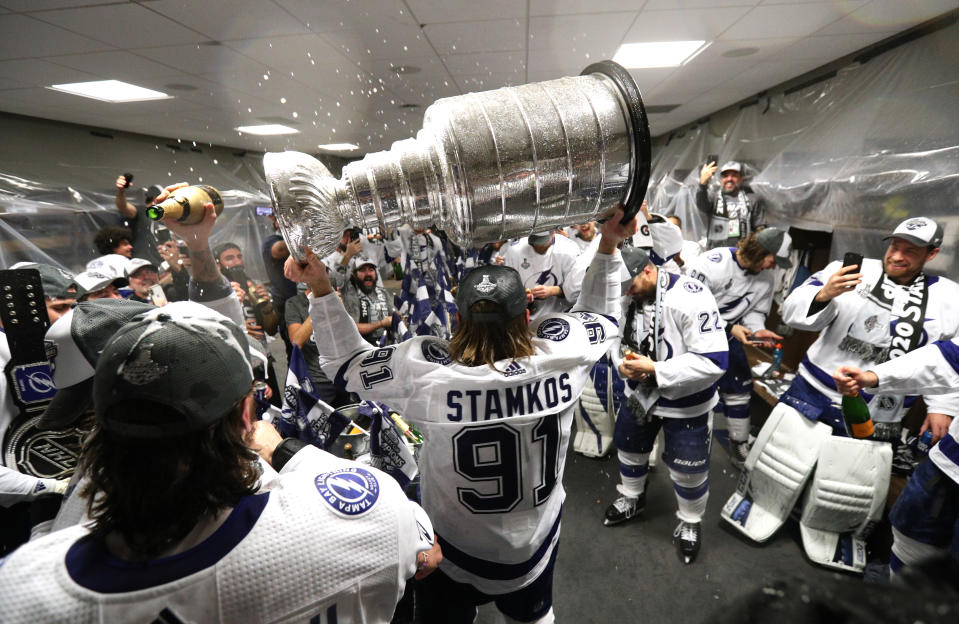What makes the Stanley Cup champion Lightning so different
It isn’t as though every team that survives four postseason rounds to win the Stanley Cup comes across as divisive and fans the flames of hockey’s online discord with its mere championship presence alone. But there is something distinctly harmonious about the reaction and conversation abound since the Tampa Bay Lightning defeated the Dallas Stars in the first NHL’s championship series to be contested in a bubble, and for finally winning it all after a decade run of near-unparalleled success.
It could be because the Lightning are unique in their ability to satisfy the set of principles that just about anyone holds while viewing the game through their own lens.
The Lightning fulfil the new-age ideal, clearly, as a team built almost entirely around the concept of scoring goals. With its focus on high-end skill, hockey know-how, and talent that doesn’t necessarily fit into a specific, antiquated box or run in concert with typical consensuses, they’ve been the highest-scoring team of the last decade, and have likely been the most exciting and aesthetically pleasing unit, too.
But what the Lightning can also do is please the purist. With repeated failure in the postseason over the last decade, the most recent being the peak of their humiliation, this is an organization that has learned just about every lesson it could along the way and made changes to its process to reflect that. Many in tune with the sport when the New York Islanders and Edmonton Oilers were monopolizing Stanley Cups many decades ago would argue that these realizations alone are the reason the Lightning’s experiment finally worked.
Perhaps this ability to placate just about everyone is the mark of a truly exceptional team, and a franchise that’s simply done it better than any other since Steven Stamkos and Victor Hedman were selected with the No. 1 and No. 2 selections, respectively, over the space of two summers more than a decade ago.
In that time, the Lightning have built something that can’t be scoffed at, that demands your appreciation, that has something for just about everyone.
Here’s how they finally became the crowd-pleasing Stanley Cup champions.

An incredible core
Not a single team has a more robust framework to piece players around than the Lightning, a team that’s brought in some incredible talent with a measure of relentlessness over the 12-year process of building a winner.
The two leanest seasons since the franchise took its lumps for about a decade following expansion presented the opportunity to draft two of the single-best players of this era in Stamkos and Hedman. In basically every draft since, they have added key pieces to support the two pillars of the franchise.
If these selections weren’t made at every which point on the draft board, there would be an argument for it being a perfect methodical build. Because between Nikita Kucherov, Andrei Vasilevskiy, Brayden Point, Ondrej Palat and Anthony Cirelli, all of whom were drafted over a five-year span and many of whom were overlooked for various reasons, the Lightning have managed to slot some of the very best players in the league at virtually every important position, while also filing utility spots with comparably premium talent as well.
What’s interesting is that the highest selection across a span of bringing in multiple major award winners, and the remaining foundation of a historically brilliant team, is that the highest selection was spent on Jonathan Drouin, who the Lightning expertly flipped for a core piece that better fit their process — and who is rounding into a special talent himself — in Mikhail Sergachev.
On a team built almost exclusively through the draft, Ryan McDonagh is the only member of the core group who established his game elsewhere first. McDonagh was acquired two-and-a-half seasons ago, along with J.T. Miller, for a collection of prospects and draft capital, and has provided that next dominant layer to create mismatches behind Hedman.
There are several other players integral to this system, and who blur the lines when assessing the Lightning’s core group. But if one more member of the organization deserves that designation, it’s the head coach.
Jon Cooper is the longest-serving head coach in the NHL for a reason, and an asset worth building around himself, as the Lightning have done beautifully.

An acknowledgement
As the key decision maker for the Lightning throughout their build, Steve Yzerman’s fingerprints are all over this championship and he obviously deserves a load of credit despite no longer being with the organization. But it did take another perspective to parlay Yzerman’s work into the crowning achievement the Lightning experienced Monday night.
Hockey is a strange, strange game in the fact that fulfilling the main objectives — which are scoring goals and preventing goals — maybe better than any other team in the regular season often isn’t enough when the postseason rolls around. It’s a game that changes drastically when the threshold is crossed and the Stanley Cup playoffs begin. The Lightning were punished by this reality more severely than any other team in history after their historical 2018-19 season ended in a four-game, first-round sweep at the hands of the Columbus Blue Jackets.
It sounds completely backwards, but it made the Lightning realize that being the highest-scoring team, with arguably the league’s best defenseman and league’s best goaltender leading the charge from a defensive standpoint, wasn’t enough. Tampa needed to add some of the elements that seem to matter more when the game is elevated beyond the normal feel and tone, and Yzerman’s successor, Julian BriseBois, expertly added that layer — even if some of the components raised some eyebrows.
The first step toward becoming more postseason-tested was acquiring Patrick Maroon, who was bought up in free agency after winning the Stanley Cup a few months prior with the St. Louis Blues. Neither a scorer or a reliable defensive forward, Maroon didn’t fit into the typical Lightning ideal, but instead arrived as something of a healer for the team and provided full value on his discount contract for his experience and leadership.
The Lightning would concede after an unspectacular start to the season that they needed impact performers lower in the lineup. BriseBois paid incredibly high prices in the lead-up to the trade deadline — a first-round pick apiece — for two forwards (with term) in Blake Coleman and Barclay Goodrow, who would provide the Lightning with an element they had been missing on the third line with Yanni Gourde.
The “gnats” were a nightmare for opponents, consistently applying pressure and raising the spirit of the Lightning, while also providing invaluable bits of offence throughout the run.
BriseBois also pounced on the opportunity to add presence to the back end, signing Zach Bogosian after he was bought out midseason by the Buffalo Sabres. Bogosian was used in multiple ways, but went on to log more than 150 minutes at 5-on-5 with Hedman, and together the pair did not allow a single goal.
Would they have saved the Lightning from humiliation two springs ago, it’s hard to say. But Maroon, Coleman, Goodrow and Bogosian were together integral, representing the finishing touches for a championship roster.
A destination
For just about any other team, losing a player as good, as important, as Stamkos for all but two minutes and 47 seconds would simply be too much to overcome. Not only did the Lightning lose the talent itself, but were also in many respects without a significant segment of their financial wherewithal to assist in the championship run.
It takes superior depth to offset that sort of loss, to not be hurt by wasted money, and maybe the biggest difference between the Lightning and every other franchise is their ability to nurture their unbreakable depth.
The Lightning have complete buy-in as a franchise, top to bottom. This is an organization that has sold its players on the concept of success (and Florida tax breaks), and avoided signing a single poorly-valued contract through the maintenance of this internal hierarchy.
And beyond preserving their assets, their efficient business model attracts other parties interested in winning, leading to unmatched depth. All but one player inside the bubble dressed at one point for the Lightning, and nine defensemen with legitimate NHL experience played meaningful roles throughout. This includes Kevin Shattenkirk, who chose the Lightning after being bought out by the Rangers; Bogosian, who also had his chance to sign with any contender after being set free; and Luke Schenn, who swallowed his pride and kept grinding because being a bit part is worth it when the team wins a championship.
There is not a more attractive destination as an NHL player, and those that chose to be a part of something special instead of squeezing every last penny they could from the system were rewarded for it.
More NHL coverage on Yahoo Sports

 Yahoo Sports
Yahoo Sports 


